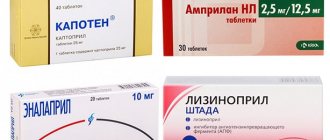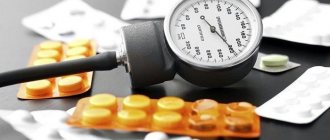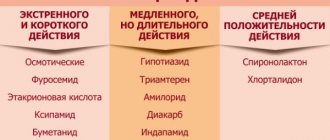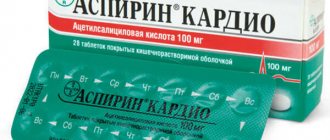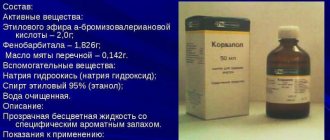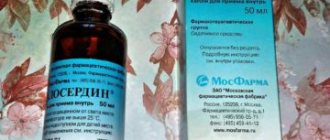Composition and release form
The main active ingredient is telmisartan. The drug is available in dosages of 20, 40 and 80 mg. The usual daily dose is 40 mg. If necessary, it can be increased to 80 mg. The maximum therapeutic effect develops after 4-8 weeks of therapy with Hypotel 80. Instructions for use recommend a single dose per day.
Auxiliary components: mannitol, Mg stearate, meglumine, Na hydroxide, crospovidone. The package contains 3 blisters of 10 tablets or 2, 4 or 6 blisters of 14 tablets. The drug is taken orally, regardless of food intake; the tablets are not intended for resorption under the tongue.
For hypertension, regular monitoring of blood pressure is necessary.
Pharmacological authorities
Pharmacodynamics.
The mechanism of action.
Telmisartan is a specific and effective angiotensin II receptor antagonist (type AT1). Telmisartan, with a very high affinity, replaces angiotensin II at the sites of its binding to AT1 subtype receptors, which are responsible for the activity of angiotensin II. Telmisartan does not have any partial agonistic effect on the AT1 receptor. Telmisartan selectively binds
AT1 receptor. We are waiting for the connection. Telmisartan does not exhibit affinity with other receptors, including AT2 and other less affected AT receptors. The functional role of these receptors is unknown, as is the unknown effect of their possible “overstimulation” with angiotensin II, which is expected to occur with the infusion of telmisartan. Telmisartan reduces aldosterone levels in blood plasma. Telmisartan does not inhibit renin in human plasma and does not block ion channels. Telmisartan does not inhibit angiotensin-converting enzyme (kininase II), an enzyme that also destroys bradykinine. Therefore, the potency of bradykinin receptor-conducting side effects should not be observed.
In humans, telmisartan at a dose of 80 mg may significantly inhibit arterial pressure caused by angiotensin II. The blocking effect persists for 24 years and disappears until 48 years.
Pharmacokinetics.
Soaked up. When soaking up telmisartan, the adsorbed quantities are separated. The average absolute bioavailability of telmisartan becomes close to 50%. When telmisartan is ingested for an hour, the decrease in the area under the plasma concentration-hour curve (AUC) for telmisartan varies from approximately 6% (40 mg) to 19% (160 mg). 3 years after administration, the blood plasma concentration remains the same, regardless of whether telmisartan is taken immediately or afterward.
Linearity/non-linearity. It is important that small decreases in AUC do not cause a decrease in therapeutic efficacy. There is no linear continuity between the dose and that of blood plasma. Cmax and lower AUC increase disproportionately at doses greater than 40 mg.
Rozpodil. Telmisartan actively binds to plasma proteins (> 99.5%), mainly albumin and alpha-1 acid glycoprotein. The average volume of the section (Vss) becomes approximately 500 l. Metabolism. Telmisartan is metabolized by conjugation to the output glucuronide. The pharmacological activity of the conjugate has not been established. Vivedennya. Telmisartan is characterized by biexponential pharmacokinetics with a terminal half-life > 20 years. The maximum plasma concentration (Cmax) and the minimum AUC increase disproportionately to the dose. There is no data on clinically significant accumulation of telmisartan when administered at recommended doses. Blood plasma concentrations were higher in women and lower in men, with no consistent effect on effectiveness.
After oral administration, telmisartan is mostly excreted in the feces, mainly as it remains unchanged. Cumulative excretion becomes <1% of the dose. The normal plasma clearance (Сltot) is high (approximately 1000 ml/min.) equal to the hepatic blood flow (approximately 1500 ml/min.).
Particular categories of patients.
Children. The results of pharmacokinetics studies in children are consistent with those in adults and confirm the non-linearity of telmisartan, zocrem, for Cmax.
Become. Blood plasma concentrations Cmax and AUC in women are approximately 3 and 2 times higher than in men.
Summer age patients. The pharmacokinetics of telmisartan does not vary in people aged under 65 years of age or older. Patients with impaired nirofunction. In patients with mild to moderate to severe levels of nirconic deficiency, plasma concentrations increased by 2 times. However, patients with nitric deficiency who underwent dialysis had low plasma concentrations. Telmisartan has a high affinity for plasma proteins in subjects with nitric deficiency and cannot be eliminated by dialysis. In patients with neurological deficiency, the withdrawal period does not change. Patients with impaired liver function. Pharmacokinetic studies in patients with liver damage revealed an increase in absolute bioavailability to approximately 100%. In patients with liver failure, the period of nutrition does not change.
pharmachologic effect
Telmisartan inhibits angiotensin II-sensitive receptors and acts on the renin-angiotensin-aldosterone system:
- The liver produces angiotensinogen, a substance from the group of peptides, which, under the influence of the enzyme renin, is converted into angiotensin I.
- Renin is synthesized by the juxtaglomerular apparatus of the kidneys. The release of renin is promoted by activation of the sympathetic nervous system under the control of β1-adrenergic receptors.
- Their activation enhances the production of renin and leads to activation of the entire system.
- Other important stimuli for its production include a decrease in renal perfusion and a decrease in the volume of circulating fluid - hypovolemia.
Angiotensin I is converted to angiotensin II. This process occurs under the influence of the angiotensin-converting enzyme, ACE, contained in the endothelial cells of blood vessels.
RAAS
Angiotensin II acts on target organs. Both effects together lead to increased blood pressure:
- Stimulates receptors located in blood vessels and has a direct vasoconstrictor effect.
- Angiotensin acts on adrenal receptors and stimulates the secretion of aldosterone, which leads to sodium retention and increased potassium loss. In response to sodium retention, the amount of antidiuretic hormone increases, which in turn retains water in the body, leading to an increase in circulating fluid and an increase in blood pressure.
Telmisartan blocks receptors, as a result of which angiotensin II cannot realize its functions in target organs.
Indications for use
Hypotel tablets and its Russian analogues are used for:
- essential arterial hypertension;
- chronic form of heart failure;
- diabetic nephropathy and for its prevention;
- proteinuria;
- angiopathy.
The drug can also be taken to prevent the occurrence of heart and vascular diseases in patients with coronary heart disease, stroke and type II diabetes mellitus, as well as to reduce the risk of ventricular arrhythmias.
Taking the drug according to the instructions leads to a number of main positive effects:
- a decrease in pressure in the kidneys, a change in the input-electrolyte balance, a decrease in proteinuria have a complex protective effect on the kidneys;
- weakening of peripheral vascular resistance causes a decrease in blood pressure;
- protective effect on the heart and blood vessels.
Appearance of the package
Of all the drugs in the group, telmisartan is the most lipophilic, which allows the drug to penetrate into the deep layers of tissue and provide effective blockade of AT1 receptors throughout the body. The long half-life (more than 20 hours) also enhances effectiveness.
Hypotel
Compound
Telmisartan
Indications
- treatment of essential hypertension in adults
- prevention of cardiovascular diseases in patients with concomitant atherothrombotic cardiovascular disease (CHD, stroke or history of peripheral artery disease), type II diabetes mellitus with documented target organ damage
Contraindications
- hypersensitivity to the components of the drug
- pregnancy period and women of reproductive age who may be pregnant
- obstructive biliary disorders; severe liver dysfunction
Directions for use and doses
Treatment of hypertension. The usual effective dose is 40 mg/day. A daily dose of 20 mg may be sufficient for some patients. In cases where the desired effect is not achieved, the dose of telmisartan can be increased to 80 mg 1 time per day. Alternatively, telmisartan can be given in combination with thiazide diuretics, such as hydrochlorothiazide, which has demonstrated additional blood pressure reduction when used with telmisartan. When considering increasing the dose, it must be taken into account that the maximum antihypertensive effect is generally achieved after 4-8 weeks from the start of treatment.
Prevention of cardiovascular diseases. The recommended dose is 80 mg 1 time per day. The effectiveness of telmisartan in doses less than 80 mg in preventing cardiovascular disease is unknown. At the beginning of treatment with telmisartan in order to prevent cardiovascular diseases, it is recommended to monitor blood pressure and, if necessary, adjust the dose of drugs that lower blood pressure.
Special groups of patients. Impaired renal function. Experience in treating patients with renal failure or patients on hemodialysis is limited. It is recommended that such patients begin treatment with a low dose of 20 mg. For patients with mild to moderate renal failure, no dose adjustment is required. The simultaneous use of telmisartan and aliskiren in patients with diabetes mellitus or impaired renal function (glomerular filtration rate (GFR) <60 ml/min/1.73 m2) is contraindicated.
Liver dysfunction. Hypotel is contraindicated in patients with severe liver dysfunction. For patients with mild or moderate liver dysfunction, the daily dose should not exceed 40 mg 1 time per day.
Elderly patients. No dose adjustment is required for elderly patients.
Mode of application. Take Hipotel once a day with a sufficient amount of liquid, regardless of meals.
Store tablets in an airtight blister to protect from moisture. Tablets should be removed from the blister immediately before use.
Overdose
There is insufficient information about overdose in humans.
Symptoms. Significant manifestations of telmisartan overdose were arterial hypotension and tachycardia; Bradycardia, dizziness, increased plasma creatinine concentrations and acute renal failure have also been reported.
Therapy. Telmisartan is not eliminated by hemodialysis. Patients should be closely monitored and receive symptomatic and supportive therapy. Therapy depends on the time elapsed after taking the drug and the severity of symptoms. Recommended measures include inducing vomiting and/or gastric lavage. When treating an overdose, activated carbon can be used. Plasma electrolyte and creatinine levels should be checked frequently. If arterial hypotension occurs, the patient should be placed on his back and assistance should be provided to quickly replenish the volume of fluid and salt in the body.
Side effects
Infections and infestations: upper respiratory tract infections, including pharyngitis and sinusitis, urinary tract infections, including cystitis; sepsis, including death.
From the blood and lymphatic system: anemia, thrombocytopenia, eosinophilia.
From the immune system: hypersensitivity, anaphylactic reactions.
Metabolism: hyperkalemia, hypoglycemia (in diabetic patients).
Mental disorders: depression, insomnia, anxiety.
From the nervous system: syncope, drowsiness.
From the organ of vision: visual impairment.
From the organ of hearing, vestibular apparatus: vertigo.
From the heart: bradycardia, tachycardia.
Vascular disorders: arterial hypotension, orthostatic hypotension.
From the respiratory system, chest and mediastinal organs: dyspnea, cough, interstitial lung disease.
From the digestive system: abdominal pain, diarrhea, dyspepsia, flatulence, vomiting, discomfort in the stomach, dry mouth.
From the hepatobiliary system: impaired liver function/liver disorders.
From the skin and subcutaneous tissue: increased sweating, itching, rashes, erythema, angioedema (including fatal), drug-induced dermatitis, toxic dermatitis, eczema, urticaria.
From the musculoskeletal system and connective tissue: myalgia, back pain (eg sciatica), muscle cramps, arthralgia, pain in the extremities, pain in the tendon (symptoms similar to tendonitis).
From the urinary system: impaired renal function, including acute renal failure.
General disorders: chest pain, asthenia (weakness), flu-like symptoms.
Laboratory data: increased creatinine in the blood, increased uric acid in the blood, increased liver enzymes, increased CPK levels in the blood, decreased hemoglobin.
Use during pregnancy
Angiotensin II receptor antagonists should not be prescribed to pregnant women or women who may be pregnant. If pregnancy is confirmed during treatment with this drug, its use should be discontinued immediately and alternative treatment initiated if necessary.
Storage conditions
At a temperature not exceeding 25 °C in the original packaging.
See other drugs:
Mikardis | Prytor
The description of the drug "Hipotel" on this page is a simplified and expanded version of the official instructions for use. Before purchasing or using the drug, you should consult your doctor and read the instructions approved by the manufacturer.
How to buy Hipotel on YOD.ua?
Do you need the drug Hipotel?
Order it right here! You can reserve any medicine on YOD.ua: you can pick up the medicine itself or order delivery at a pharmacy in your city at the price indicated on the website. The order will be waiting for you at the pharmacy, about which you will receive a notification in the form of SMS (the possibility of a delivery service must be checked with partner pharmacies). On YOD.ua there is always information about the availability of the drug in a number of the largest cities of Ukraine: Kyiv, Dnieper, Zaporozhye, Lvov, Odessa, Kharkov and other megacities. While in any of them, you can always easily and simply order medications through the YOD.ua website, and then go to the pharmacy for them at a convenient time or order delivery.
Please note: You will need a doctor's prescription to order and receive prescription drugs.
Order Hipotel today in a simple and convenient form thanks to Yod.ua. We work for you!
Read completely
Side effects
Undesirable effects from taking Hypotel are associated with dysfunction of angiotensin II:
- Hypotension.
Hipotel and its analogues are capable of excessively reducing blood pressure. The risk group includes patients with hypovolemia, hyponatremia and dehydration. Concomitant use of diuretics increases the risk of hypotension. The risk is also higher in patients with left ventricular obstruction. To reduce the likelihood of an excessive drop in pressure, it is necessary to carefully select the dosage and regularly monitor the indicators.
- Hyperkalemia.
Taking Hypotel reduces the production of aldosterone and potassium retention in the body. Most often, this effect occurs with reduced renal function, especially in elderly patients.
- Kidney failure.
Possible in patients with bilateral renal stenosis as a result of a drop in renal pressure associated with other mechanisms.
- Teratogenic effect.
Drugs of this group cause fetal deformities and the impossibility of normal organogenesis. Angiotensin II is an important factor in angiogenesis - the formation of blood vessels; suppression of angiotensin II in the fetus disrupts their development. Therefore, it is extremely dangerous to use such drugs during pregnancy.
In contrast to ACE inhibitors, the risk of dry cough and angioedema when taking Hypotel and its analogues, according to reviews from users, is minimal.
Drug interactions
- Diuretics.
When telmisartan is co-administered with loop or thiazide diuretics, the risk of hypotension increases. Like other drugs that inhibit the renin-angiotensin-aldosterone system, telmisartan can cause hyperkalemia. The risk increases when taken together with potassium-sparing diuretics, ACE inhibitors, NSAIDs, and potassium supplements. If simultaneous use is necessary, it is necessary to adjust the dosage regimen, starting or continuing with small dosages and gradually increasing to the optimal one.
- Lithium.
When combining ACE inhibitors, telmisartan with lithium preparations, there are cases of increased lithium levels in the blood serum. If coadministration is necessary, serum lithium levels should be monitored regularly.
- NSAIDs.
Nonsteroidal anti-inflammatory drugs can reduce the hypotensive effect of telmisartan. In patients with impaired renal function, their combination can cause a deterioration in their function up to acute renal failure. Patients, especially the elderly, should maintain sufficient fluid intake and periodically check their kidney function.
The simultaneous use of telmisartan with hypotonic drugs of other groups mutually enhances their effect on the body.
special instructions
renovascular hypertension.
There is an increased risk of severe hypotension and renal failure if patients with bilateral renal artery stenosis or solitary renal artery stenosis are treated with medications that affect the renin-angiotensin-aldosterone system.
Kidney failure and kidney transplantation.
When Hypotel is prescribed to patients with impaired renal function, periodic monitoring of plasma potassium and creatinine levels is recommended.
There is no experience with the use of Hypotel in patients with recent kidney transplantation. Decrease in BCC.
Symptomatic hypotension, especially after the first dosage of the drug, may occur in patients with reduced blood volume and/or sodium levels, which occurs as a result of diuretic therapy, dietary salt restriction, diarrhea or vomiting.
Such conditions, especially decreased intravascular volume and/or sodium levels, should be corrected before taking Hypotel. Double blockade of the renin-angiotensin-aldosterone system.
As a consequence of inhibition of the renin-angiotensin-aldosterone system, hypotension, syncope, hyperkalemia and changes in renal function (including acute renal failure) were noted in more sensitive patients, especially if drugs that affect this system were included in combination therapy.
Therefore, double blockade of the renin-angiotensin-aldosterone system (in particular, the use of telmisartan with other blockers of the renin-angiotensin-aldosterone system) is not recommended. If concurrent use is necessary, careful monitoring of renal function is suggested. Other conditions requiring stimulation of the renin-angiotensin-aldosterone system.
In patients in whom vascular tone and renal function depend primarily on the activity of the renin-angiotensin-aldosterone system (in particular in patients with severe congestive heart failure or severe kidney disease, including renal artery stenosis), use Hypotel with other drugs that affect on the renin-angiotensin-aldosterone system, can lead to acute arterial hypotension, hyperazotemia, oliguria, and rarely to acute renal failure.
Primary hyperaldosteronism.
Patients with primary hyperaldosteronism generally do not respond to antihypertensive drugs that act by blocking the renin-angiotensin system.
Therefore, telmisartan is not recommended for them. Aortic and mitral valve stenosis, obstructive hypertrophic cardiomyopathy
.
As with other vasodilators, the drug is prescribed with extreme caution to patients diagnosed with aortic stenosis, mitral valve stenosis, or obstructive hypertrophic cardiomyopathy. Hyperkalemia.
During the entire period of use of drugs acting on the renin-angiotensin-aldosterone system, hyperkalemia may occur, especially in the presence of renal failure and/or heart failure. In elderly patients, patients with renal failure, diabetes, in patients simultaneously taking other medications that can cause an increase in potassium levels, and/or patients with concomitant diseases, hyperkalemia can be fatal. Before concomitant use of drugs that inhibit the renin-angiotensin system, the benefit-risk ratio should be assessed. The main risk factors for the development of hyperkalemia that you need to pay attention to:
- diabetes mellitus, renal failure, age over 70 years;
- combination therapy with one or more other drugs that affect the renin-angiotensin system and/or potassium supplements. Drugs or therapeutic groups of drugs that may precipitate hyperkalemia include potassium-containing salt substitutes, potassium-sparing diuretics, ACE inhibitors, angiotensin II receptor antagonists, NSAIDs (including selective COX-2 inhibitors), heparin, immunosuppressants (cyclosporine or tacrolimus), and trimethoprim;
- concomitant diseases, especially dehydration, acute cardiac decompensation, metabolic acidosis, impaired renal function, sharp deterioration of the kidneys (particularly due to infectious diseases), cell lysis (particularly due to acute ischemia of the limbs, acute necrosis of skeletal muscles, extensive trauma).
Patients at risk should undergo careful monitoring of plasma potassium concentrations. Liver failure.
The drug should not be prescribed to patients with cholestasis, obstructive diseases of the bile ducts and severe liver failure (see CONTRAINDICATIONS), since telmisartan is excreted mainly in bile.
In such patients, a decrease in the hepatic clearance of telmisartan can be expected. The drug should be prescribed with caution to patients with moderate to moderate liver failure. Patients with diabetes mellitus taking insulin or antidiabetic drugs
.
During treatment with telmisartan, these patients may develop hypokalemia. The need for appropriate monitoring of blood glucose levels in such patients should be considered. According to indications, dosage adjustment of insulin or antidiabetic medications may be required. In patients with diabetes mellitus at cardiovascular risk (diabetic patients with concomitant coronary artery disease), the risk of fatal myocardial infarction and sudden cardiovascular death may be higher when treated with antihypertensive drugs such as angiotensin II receptor antagonists and ACE inhibitors. In patients with diabetes mellitus, the course of concomitant coronary artery diseases may be asymptomatic, so they may be undiagnosed. Patients with diabetes mellitus should be carefully evaluated, particularly by stress testing, to identify and treat concomitant coronary artery disease before prescribing medication. Ethnic differences.
Like all other angiotensin II receptor antagonists, telmisartan is considered less effective in lowering blood pressure in black patients than in representatives of other races.
This is probably explained by the greater prevalence of low renin conditions in black patients with hypertension. Other.
As with any other antihypertensive drug, a significant decrease in blood pressure in patients with ischemic cardiopathy or ischemic cardiovascular disease can lead to myocardial infarction or stroke.
The ability to influence the reaction speed when driving vehicles or working with other mechanisms.
Studies of the effect of telmisartan on the ability to drive a car and operate machinery have not been conducted.
But you need to keep in mind that dizziness or hypersomnia may occur during antihypertensive therapy. Use during pregnancy or breastfeeding.
The use of angiotensin II receptor antagonists is not recommended during the first trimester of pregnancy.
The use of angiotensin II receptor antagonists is contraindicated in the second and third trimesters of pregnancy (see CONTRAINDICATIONS). There is insufficient data on the use of telmisartan in pregnant women. If continued therapy with angiotensin II receptor antagonists is not considered essential, patients planning pregnancy should switch to antihypertensive drugs that have an established safety profile for use during pregnancy. If pregnancy is established, treatment with angiotensin II receptor antagonists should be stopped immediately and, if necessary, alternative treatment initiated. During the second and third trimesters of pregnancy, angiotensin II receptor antagonists are known to cause fetotoxicity (decreased renal function, oligohydramnios, delayed cranial bone formation) and neonatal toxicity (renal failure, hypotension, hyperkalemia). If the use of angiotensin II receptor antagonists began in the second trimester of pregnancy, it is suggested to conduct an ultrasound of the function of the kidneys and cranial bones. Children whose mothers took angiotensin II receptor antagonists should be carefully examined for the presence of arterial hypotension (see CONTRAINDICATIONS). Due to the lack of information regarding the use of telmisartan during breastfeeding, this drug is not recommended for use in women who are breastfeeding. Alternative treatments with a better established safety profile are preferred, especially when breastfeeding a newborn or premature infant. Children.
Hipotel is contraindicated in children (under 18 years of age) due to limited information on the safety and effectiveness of the drug in this category of patients.
Negative effects of angiotensin II on the body
In the body, blood pressure is regulated by two important systems: the sympathetic nervous system and the renin-angiotensin-aldosterone system. The sympathetic controls the work of the heart, the RAAS is responsible for the volume of circulating fluid. Their joint activity determines vascular tone and pressure indicators.
The effect of angiotensin II on the body
Angiotensin II has a number of different physiological effects and is one of the key links in the pathogenesis of various diseases, including arterial hypertension and kidney diseases accompanied by albuminuria:
- Inflammation.
Angiotensin II increases the secretion of inflammatory cytokines and promotes the formation of superoxides.
- Changes in kidney function.
Stimulates the production of aldosterone, which leads to changes in water-electrolyte balance and fluid retention. Angiotensin II, through direct vasoconstriction and enhancement of the sympathetic nervous system, alters renal hemodynamics and blood flow. This process leads to increased renal perfusion and increased renin secretion. This action does not allow the pressure to decrease.
- Total peripheral vascular resistance.
Angiotensin II directly causes constriction of the arteries, which leads to an even greater increase in blood pressure, and stimulates sympathetic vascular activity.
- Changing the structure of the cardiovascular system.
Angiotensin II causes an enlargement of the left ventricle of the heart and the vascular wall. Activation of angiotensin receptors stimulates the production of growth factors that contribute to an increase in heart size. Extracellular matrix proteins stimulate fibrosis of cardiac and vascular tissues.
Comparative characteristics of sartans and ACE inhibitors
Table of other drugs from the sartan group.
| Losartan Valsartan | Tablets with a short duration of action, require twice daily dosing |
| Irbesartan Candesartan | New generation drugs with a single dose per day |
Advantages of telmisartan over ACE inhibitors:
- ACE inhibitors prevent the transition of angiotensin I to angiotensin II, but this process does not stop completely;
- under the influence of enzymes such as chymase and chymotrypsin, partial conversion of angiotensin I occurs, and all the negative effects on the body are realized;
- This process, although significantly limited, may be sufficient for the development of diseases;
- Sartans block the receptors themselves that are affected by angiotensin II - angiotensin receptors of the first type, and prevent undesirable consequences.
Sartans and ACE inhibitors
The effect of the drug Hypotel on the body
Angiotensin II increases blood pressure and triggers a number of negative processes in the body, which ultimately leads to a reduction in the duration and quality of life. Sartans prevent these effects.
Telmisartan can be taken once a day, which is a significant advantage and allows you to avoid regular changes in blood pressure, including dangerous morning ones, which reduces the risk of stroke.
In addition to the main pharmacological action, sartans have a number of positive effects on the entire human body.
Protection against heart attack and stroke
Cardiovascular pathologies are the most common cause of death among the population. Telmisartan is a drug with proven effectiveness for the prevention of heart attack and stroke due to progressive vascular atherosclerosis.
Inflammation of cholesterol plaques underlies their pathogenesis. At the beginning of the disease, oxidative processes occur, then the inflammatory response is activated, and the lumen of the vessel narrows as a result of an increase in cholesterol plaque.
Atherosclerosis
Antagonists of angiotensin II receptors and hypotel in particular exhibit antiatherosclerotic effects by increasing the stability of cholesterol plaques. This effect is most pronounced for preventing the disease than in later stages.
Telmisartan effectively inhibits left ventricular hypertrophy, which is also an important factor in preventing heart attack.
Protection against diabetes
Telmisartan increases the sensitivity of cells to insulin, which helps prevent or cure type II diabetes, reduce the level of “bad” cholesterol and improve blood lipids. In terms of this effect, telmisartan is approximately 20 times more powerful than losartan, while losartan itself reduces the risk by 57%.
Also, its intake prevents the development of heart and vascular diseases associated with diabetes. Sartans affect the hormone leptin, thereby helping to fight excess weight.
The antifibrotic properties of the drug protect against kidney nephropathy in diabetes, inhibit the development of the disease and promote cure. Taking Hypotel for this purpose is acceptable even if blood pressure is initially normal. The combination with aspirin further increases the protective effect of the drug.
Protecting Muscles from Sarcopenia
Sarcopenia is a disease associated with a decrease in muscle mass with aging and is one of the causes of mortality in old age. In addition, the disease significantly reduces the quality of life and makes a person weak and helpless.
Among other negative effects of angiotensin is its ability to accelerate the progression of sarcopenia. Its blockade helps prevent muscle loss. Telmisartan (Hypotel) is most effective, but other drugs in the group also reduce muscle atrophy.
Sarcopenia in the elderly
Protecting the Brain from Alzheimer's Disease
Today, the disease is incurable and leads to the death of the patient after 5-7 years. The development of the disease is accompanied by a decrease in memory, thinking abilities, and senile dementia. One of the reasons for its onset is the influence of angiotensin II. Sartans are promising drugs for the prevention of Alzheimer's disease.
In the near future, studies are planned on their effectiveness in the treatment of the disease and other mental disorders. Sartans have a protective effect even in small dosages.
Protection against prostate adenoma and uterine fibroids
Male prostate adenoma and female uterine fibroids are a real epidemic in modern society. The antifibrotic properties of sartans stop the growth of tumor formations and the processes of hyperplasia of prostate tissue. By blocking angiotensin, they reduce the production of hormones, thereby slowing down the growth of uterine fibroids in women.
Slow down the aging of the body
According to the results of experiments on mice, blockade of genes responsible for the sensitivity of receptors to angiotensin increases life expectancy not only due to the protection of the heart and blood vessels, but also as a result of a general decrease in the rate of aging.
Mice with a congenital deficiency of angiotensin receptors live longer than normal by about 26%. In addition, the main causes of death in mice are cancer, infectious diseases and poor kidney function. This once again suggests that sartans are capable of prolonging human life by slowing down the aging process and the rate of development of various pathologies.
Additional research is needed to confirm these speculations. However, a large number of studies have already been accumulated, giving the right to believe that the RAAS system and the regulation of angiotensin have a significant impact on the aging process of the body.
Sartans can slow down aging
Instructions for use
Tablets are prescribed for internal use without reference to food intake. The dosage is determined by the doctor. Most often, the drug is prescribed once a day. The drug has a cumulative effect and is effective one and a half months after the start of use. Dose adjustments are rare unless improvement is observed.
When a person suffers from liver dysfunction, the dose of the drug is no more than 40 mg.
Composition and properties
The main component of the drug is telmisartan, which in medicine is considered a high-quality angiotensin II receptor antagonist. The component in the medicine can be in quantities of 20 mg, 40 and 80. The drug "Hipotel" - tablets in blisters and cardboard packaging. Their quantity in a pack is 10 or 14 pcs. The drug contains elements such as sodium hydroxide, meglumine, crospovidone, mannitol. Consultation with a doctor is recommended before use.
Indications and contraindications
Diabetics can take medication to avoid associated pathologies.
The drug "Hipotel" is prescribed in the treatment of arterial hypertension, as a prophylactic against a number of lesions of the cardiovascular system in patients who have suffered heart disease, such as stroke or heart attack, as well as for the prevention of developing diseases in patients with diabetes.
Contraindications include hypersensitivity to the active ingredients of the drug, individual intolerance to the components of the drug, diseases associated with liver function. If the patient suffers from severe obstructive biliary disorders, the tablets should be abandoned. It is not recommended to use the medicine by persons under 18 years of age.
Side effects
Very rare:
- respiratory tract damage;
- emotional disorders;
- thrombocytopenia, anemia, eosinophilia;
- damage to the organs of vision;
- tachycardia, bradycardia;
- shortness of breath;
- disruption of the liver and kidneys.
Overdose
Severe dizziness can be caused by an overdose of the drug.
It has been noted that during an overdose, complications associated with a significant decrease in blood pressure, severe dizziness, uneven heartbeat turning into tachycardia, severe renal failure and an increased degree of creatinine in human blood are possible. To avoid such complications, in case of overdose it is necessary to adjust the creatinine and electrolytes in the plasma. The medication is not recommended for use together with antidepressants or medications aimed at combating arterial hypertension.



